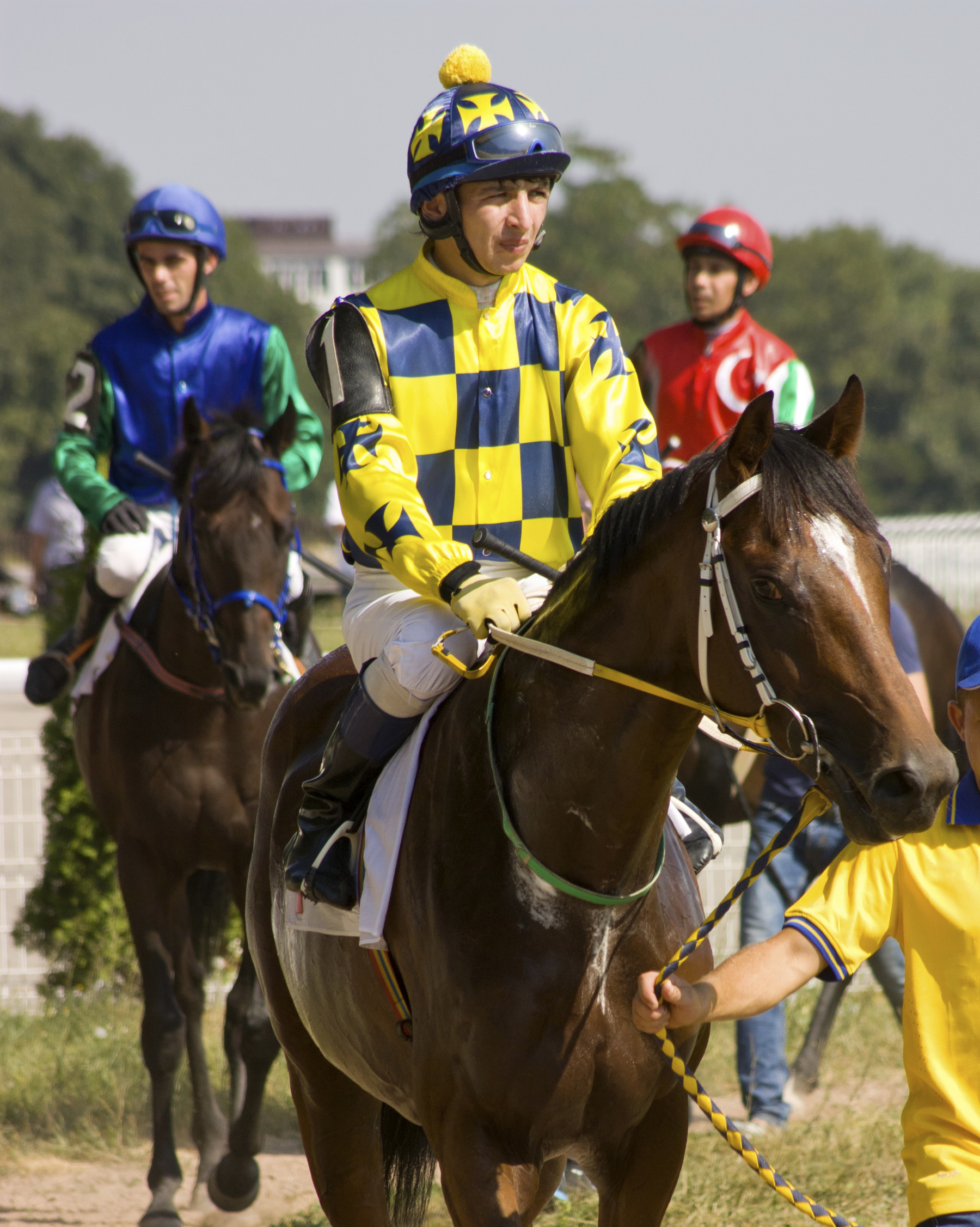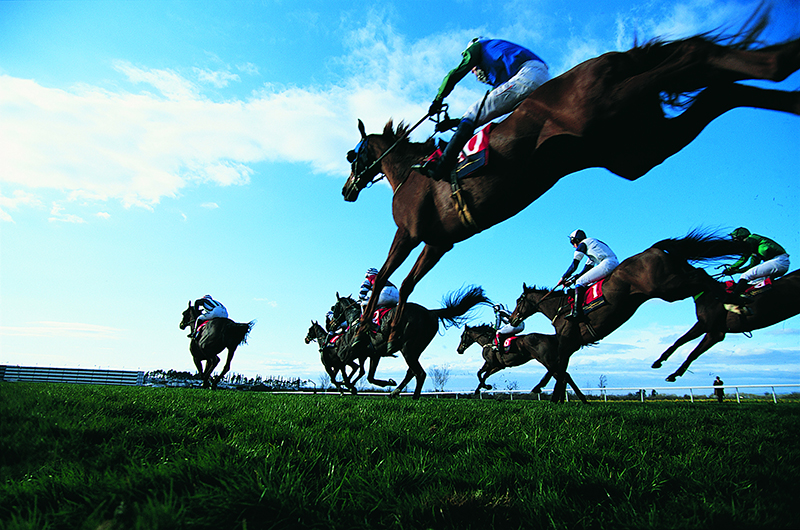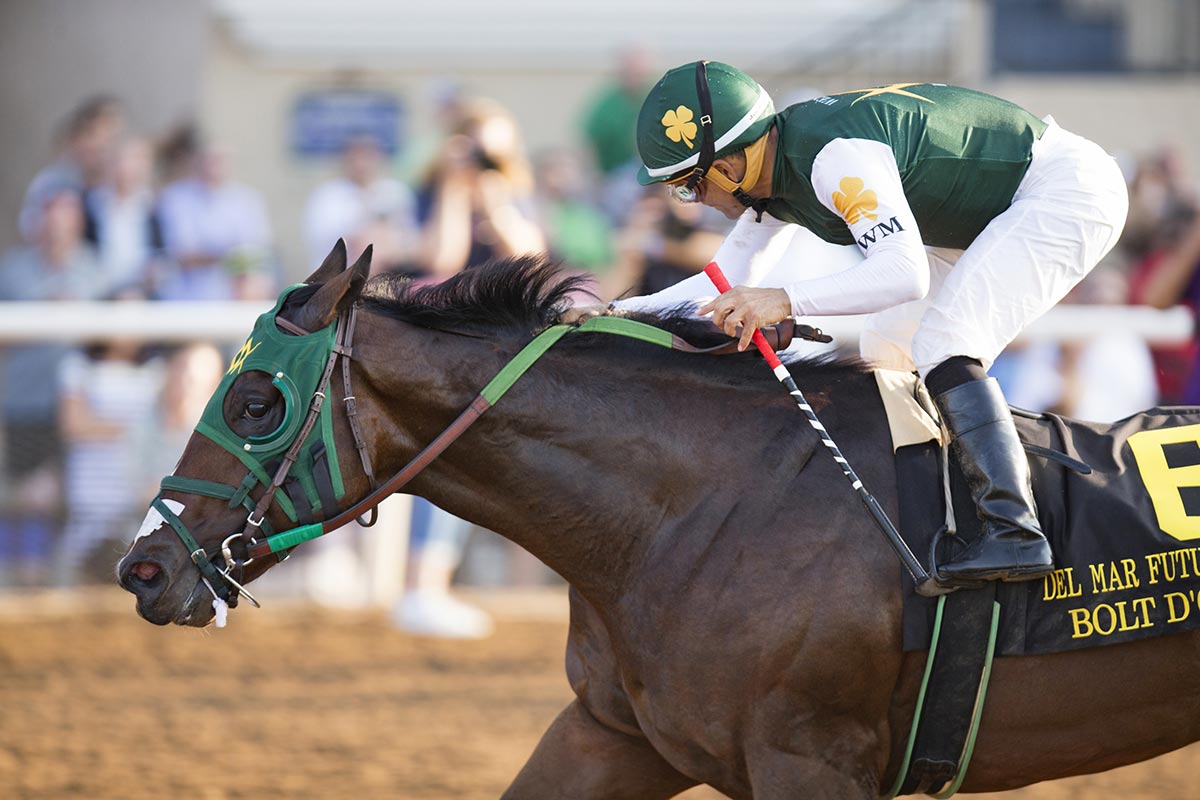
The Arabian horse originated from the Arabian Peninsula where it has been raced for centuries. This breed is smaller in size and more one paced than the Thoroughbred. It is very attractive and intelligent, generally noted for its ability to endure sustained effort over long distances. In January 2000 the Abu Dhabi one-day 100 mile race was won by a 10 year old Purebred Arab gelding, Ben Saloe, at an astonishing average speed of 12.71 mph!
The Arabian has been in Britain since the Romans conquered our shores. They raced them at Netherby (Yorkshire) long before the Thoroughbred was produced. James I kept Arabians, including the famous Markham Arabian, at Newmarket where he instituted a kind of steeplechase on Newmarket Heath. The Parliamentarians confiscated his Stud in 1648 and his horses were dispersed - most being lost from record.
The Darley Arabian, the Godolphin Arabian and the Byerly Turk from the 18th Century were to become the progenerators of the British Thoroughbred stock. Weatherby's Stud Book began in 1791 based on these three Arabians. Prior to this, the Jockey Club was founded in 1752.
By 1885 the speedy Thoroughbred had evolved to be so fast that the Purebred Arabian was no longer a match for it even when given a large allowance. So the racing of this smaller breed on official tracks was stopped. It was not until 1978 that they were returned to the tracks once more. A few racing enthusiasts from the Arab Horse Society, led by Ann Unwin, gained permission from the Jockey Club to organise Amateur flat races. Since then, for the past 22 seasons, the sport has flourished under Jockey Club Rules, on official courses and has grown to be the most active of its kind in Europe.
Read more from EquiWorld UK
Harness Racing is a form of horse racing in which the horses race at a specific gait (a trot or a pace). They usually pull a two-wheeled cart called a sulky, although racing under saddle (trot monté in French) is also conducted in Europe.
Breeds
In North America harness races are restricted to Standardbred horses, although European racehorses may also be French trotters or Russian trotters, or have mixed ancestry with lineages from multiple breeds. Orlov trotters race separately in Russia. The light cold-blooded Coldblood trotters and Finnhorses race separately in Finland, Norway and Sweden.
Standardbreds are so named because in the early years of the Standardbred stud book, only horses who could trot or pace a mile in a standard time (or whose progeny could do so) of no more than 2 minutes, 30 seconds were admitted to the book. Today, most harness races are won by Standardbreds who post times of 2 minutes or less. The horses have proportionally shorter legs than Thoroughbreds, and longer bodies. Standardbreds generally have a more placid disposition, due to the admixture of non-Thoroughbred blood in the breed.
The founding sire of today's Standardbred horse was Messenger, a gray Thoroughbred brought to America in 1788 and purchased by Henry Astor, brother of John Jacob Astor. From Messenger came a great-grandson, Hambletonian 10 (1849–1876), who gained a wide following for his racing prowess. However, it is his breed line for which he is most remembered. The lineage of virtually all North American Standardbred race horses can be traced from four of Hambletonian 10's sons.
Races
Races can be conducted in two differing gaits – trotting and pacing. The difference is that a trotter moves its legs forward in diagonal pairs (right front and left hind, then left front and right hind striking the ground simultaneously), whereas a pacer moves its legs laterally (right front and right hind together, then left front and left hind). In continental Europe, races are conducted exclusively among trotters, whereas in Australia, Canada, New Zealand, the United Kingdom and the United States races are also held for pacers.
Read more from Wikipedia...
Harness Racing - General Information
The American Quarter Horse Is One Of The World’s Most Popular Breeds
The origin of the breed can be traced to Colonial America, to the early days of our nation. At this time, sprint racing, similar to modern Quarter Horse racing today, was popular in the streets of Virginia. It gained this popularity due to the fact that participants did not need a fancy track. That is to say, they just used what was already there… the street! But in 1674 this practice was deemed illegal, as people were literally being run over in the streets!!! At this point, the horse had no official name but was called a variety of things, including the Colonial Sprinter, the Quarter Pather and the Illustrious Colonial Quarter Running Horse. Although English Thoroughbreds were raced in the new world, it wasn’t long before Colonial farmers started to breed their English ponies to a faster, sturdier horse. In 1752, a horse named Janus was imported to Virginia. He was a grandson of the Godolphin Arabian and he was quick and compact. His build worked beautifully for the breeders cause and because of this, Janus is credited as the foundation sire of the American Quarter Horse.
Over the next 150 years, the product of this breeding would come to be known as the “American Quarter Horse”. Now known as the ‘World’s Fastest Athlete’ , the term “Quarter” refers to the distance of the race, most commonly a quarter of a mile. This 440 yard distance is still known as American Quarter Horse Racing’s ‘classic distance’ today.
Important Facts About American Quarter Horse Racing
Quarter Horse racing began on a straight track of four hundred forty yards, or one quarter mile. While this is still the most prolific distance in modern racing, races are held at distances as little as 100 yards and as much as 1000 yards! The American Quarter Horse Association (AQHA), the official breed registry for quarter horses, only recognizes races run at 1000 yards or less.
With few exceptions, Quarter Horse races are run in a straight path, with horses running at top speeds for the duration of the race. Turns are rare, so many races end with several horses grouped together at the wire for an exciting photo finish!

Steeplechase racing is a thrilling and demanding equestrian sport that combines the speed and excitement of horse racing with the challenge of jumping over obstacles. It's a spectacle that has captivated audiences for centuries, and it remains a popular event around the world.
The name "steeplechase" is derived from the early races in which the course was marked by church steeples, with horses jumping over fences and ditches along the way. Today, steeplechase courses are typically more standardized, with fences and ditches placed at regular intervals to test the horses' stamina, balance, and jumping ability.
Steeplechase races are typically run over distances of 2 miles (3.2 kilometers) or more, and they can feature a variety of obstacles, including:
- Water jumps: These are ditches filled with water that horses must jump. The depth and width of the water jumps can vary depending on the course.
- Brush fences: These are fences made of brushwood or other natural materials. They are designed to test the horses' ability to navigate obstacles that are both high and wide.
- Log fences: These are fences made of logs or poles. They are often placed in pairs, with a gap between them that the horses must jump over.
- Rail fences: These are fences made of rails or planks. They are typically the shortest and easiest obstacles to jump.
In addition to the obstacles, steeplechase races also feature a variety of hazards, such as uneven terrain, loose gravel, and sudden changes in direction. These hazards can further challenge the horses and jockeys, making it a demanding and unpredictable sport.
Steeplechase racing is a sport of great skill and courage, and it requires both horses and jockeys to be in excellent physical condition. The sport's popularity stems from its combination of thrilling action, unpredictable outcomes, and the inherent drama of horses and riders overcoming difficult obstacles.
Here are some of the most popular steeplechase racing events in the world:
- The Grand National: This iconic race is held annually at Aintree Racecourse in Liverpool, England, and is considered to be the most prestigious steeplechase in the world. It is a grueling test of stamina and jumping ability, with 30 fences over a distance of 4 miles and 514 yards (7,108 meters).
- The Cheltenham Festival: This four-day festival, held annually in March at Cheltenham Racecourse in Cheltenham, England, is the pinnacle of the National Hunt season in the United Kingdom. It features a number of Grade 1 steeplechase races, including the Cheltenham Gold Cup, the Queen Mother Champion Chase, and the Ryanair Chase.
- The Nakayama Grand Jump: This race is held annually at Nakayama Racecourse in Funabashi, Japan, and is the most prestigious steeplechase in Japan. It is a test of stamina and jumping ability, with 23 fences over a distance of 3 miles and 492 yards (5,700 meters).
- The Maryland Hunt Cup: This race is held annually in April at the Glyndon Course in Glyndon, Maryland, and is the oldest and most prestigious steeplechase race in the United States. It is a test of stamina and jumping ability, with 22 fences over a distance of 4 miles and 1/2 mile (6.5 kilometers).
- The Grand Steeplechase de Paris: This race is held annually at Longchamp Racecourse in Paris, France, and is the most prestigious steeplechase race in France. It is a test of stamina and jumping ability, with 33 fences over a distance of 3 miles and 2 furlongs (5,226 meters).
Steeplechase Racing Terminology
Courtesy of the Maryland Steeplechase Association
Allowance: A race restricted to horses with certain records. Example: A “non-winners of two” allowance is open only to horses with one victory or less.
Apprentice: A relatively inexperienced jockey. The National Steeplechase Association gives apprentice jockeys the following weight allowances (deductions): Non-winners of one race, 10 pounds; non-winners of five races, seven pounds; non-winners of 10 races, five pounds. Riders must be at least 16 years old before obtaining a license.
Claiming: Certain races are designated as claiming races, where a horse may be purchased, or claimed. The claim is made and money put up before the race is run, and the purchase must go through, no matter where the horse finishes.
Furlong: The standard measure in U.S. racing. One furlong equals one eighth of a mile.
Handicap: A race in which the horses are assigned different amounts of weight to carry, according to their respective abilities and past performances. In theory, the purpose is to have all horses reach the finish line at the same time.
Hunt Meet: A sanctioned steeplechase meet in the countryside, as opposed to steeplechase races run at thoroughbred racetracks.
Hurdle: See National Fence.
Maiden: A horse that has never won a race. National Fence: A synthetic steeplechase fence used at most stops in the U.S. Consists of a steel frame stuffed with plastic “brush” and standing 54 inches high. A foam-rubber roll, covered with green canvas, is placed on the takeoff side. Horses jump the fence in stride, much like human hurdlers in track and field events.
Novice: A horse in the early stages of its steeplechase career. Novice races are held at many meets, to give horses experience over hurdles before they compete with more-seasoned jumpers.
National Fence: A man-made fence used in most steeplechasing in the U.S., so named because the standard fence was developed by the National Steeplechase Association. Consists of a steel frame stuffed with plastic “brush” and standing 52 inches high. A foam-rubber roll, covered with green canvas, is placed on the takeoff side. Horses jump the fence in stride, much like human hurdlers in track and field events. The jumps are brought to racetracks and hunt meets by truck, set up a day in advance.
National Steeplechase Association: The NSA, founded in 1895, is the governing body for steeplechase racing in the United States. Based in Fair Hill, MD, the NSA sanctions, takes entries, approves officials, and inspects courses. The NSA licenses all participants and keeps official statistics.
Paddock: Area where horses are saddled before a race.
Paddock Time: The time all horses are due to be in the paddock before the race.
Point-to-Point: A steeplechase race meet that is unrecognized by the National Steeplechase Association. Horseman participating at Point-to-Points are unlicensed and it is typically a training ground for amateur riders and events for horses preparing for sanctioned racing.
Post Time: The time that the race actually starts.
Purse: Total money distributed in a race. Winner usually collects 60 percent of total purse, with shares paid to fifth place.
Stakes: An open race which any horse can enter. Usually attracts most-talented horses. NSA requires purse of at least $25,000.
Stewards: Presiding judges or officials at a race meet. They have final decision on all matters pertaining to a race. They may levy fines on owners, trainers, or jockeys who violate the rules of racing. Typical rulings include disqualification of horses who interfere with others in a race. Each race meet has three stewards.
Timber fence: Natural, wooden fence constructed of boards, logs or posts and rails. Timber races are held as part of many race meets and typically attract good jumpers that are a little to slow to be competitive in the hurdle division. Timber races are 3-4 miles long over the countryside. Horses carry an average of 165 lbs in these races.
Wings: The panels on either side of a steeplechase fence which are designed to guide a horse to a fence.

The most prestigious race in Argentina is the Gran Premio Carlos Pellegrini, which is held annually at the Hipódromo Argentino de Palermo. The Gran Premio Carlos Pellegrini is a Group 1 race, and it is considered to be the most important race in South America.
Other important races in Argentina include the Gran Premio Nacional, the Gran Premio Ciudad de Buenos Aires, and the Gran Premio Criadores. These races are all Group 1 races, and they attract the best horses from all over the world.
Thoroughbred horse racing is a popular spectator sport in Argentina, and it is also a major economic driver. The sport generates millions of dollars in revenue each year, and it supports thousands of jobs.
Here are some of the most popular thoroughbred horse racing tracks in Argentina:
- Hipódromo Argentino de Palermo: This is the most famous racetrack in Argentina, and it is located in Buenos Aires. The track was founded in 1876, and it is one of the most important racing venues in South America.
- Hipódromo de San Isidro: This racetrack is also located in Buenos Aires, and it is a popular venue for both thoroughbred and harness racing. The track was founded in 1913, and it is home to some of the most prestigious races in Argentina, including the Gran Premio Carlos Pellegrini.
- Hipódromo de Tandil: This racetrack is located in the province of Buenos Aires, and it is a popular destination for horse racing fans from all over the country. The track was founded in 1884, and it is home to some of the most important races in the province, including the Gran Premio de Tandil.
If you are a fan of thoroughbred horse racing, then Argentina is a great place to visit. The country has a rich history of horse racing, and it is home to some of the most beautiful and well-maintained racetracks in the world.
Horse Racing - Thoroughbred - Argentina
-
Hipodromo Argentino de Palermo, Buenos Aires
 Hipodromo Argentino de Palermo is located in Buenos Aires, Argentina. One of the most prominent horse racing venues in Argentina, its installations include a 2400 meter (1.5 mile) track suitable for races in all weather. The Hipódromo introduced a technology named "Photochart" in 1947. Photochart was a photographic device that registered the precise moment when the horses crossed the end line, thus simplifying the selection of the winner in neck-and-neck outcomes.
Hipodromo Argentino de Palermo is located in Buenos Aires, Argentina. One of the most prominent horse racing venues in Argentina, its installations include a 2400 meter (1.5 mile) track suitable for races in all weather. The Hipódromo introduced a technology named "Photochart" in 1947. Photochart was a photographic device that registered the precise moment when the horses crossed the end line, thus simplifying the selection of the winner in neck-and-neck outcomes. - Hipodromo de La Plata, La Plata, Buenos Aires Province
- Hipodromo de Rosario, Rosario, Santa Fe Province
- Hipodromo de San Isidro, San Isidro, Buenos Aires Province

Thoroughbred horse racing is a popular sport in Arizona, with three racetracks offering live racing throughout the year. The tracks are:
- Turf Paradise: Located in Phoenix, Turf Paradise is the oldest and most well-known racetrack in Arizona. It offers live racing from October to May, and is home to the Arizona Derby, a Grade III stakes race.
- Rillito Park Race Track: Located in Tucson, Rillito Park is the second-largest racetrack in Arizona. It offers live racing from February to March, and is home to the Rillito Derby, a Grade II stakes race.
- Arizona Downs: Located in Prescott Valley, Arizona Downs is the smallest of the three racetracks in Arizona. It offers live racing from May to September, and is home to the Arizona Downs Derby, a Grade III stakes race.
In addition to live racing, the tracks also offer simulcast racing from tracks all over the country. This means that you can bet on races from all over the world, regardless of where you are located.
Thoroughbred horse racing is a great way to enjoy a day of excitement and fun. With three tracks to choose from, there is sure to be a race day that is perfect for you.
Here are some additional facts about thoroughbred horse racing in Arizona:
- The Arizona Thoroughbred Breeders Association (ATBA) is the governing body for thoroughbred horse racing in the state.
- The ATBA sanctions all live racing in Arizona, and also promotes the sport through education and outreach programs.
- Arizona is home to a number of successful thoroughbred horse farms, which produce some of the best racehorses in the country.
- Thoroughbred horse racing is a major economic driver in Arizona, generating millions of dollars in revenue each year.
If you are interested in learning more about thoroughbred horse racing in Arizona, there are a number of resources available online and in the state. The ATBA website is a great place to start, and you can also find information on the websites of the individual racetracks.
Horse Racing - Thoroughbred - Arizona
- Thoroughbred Horse Racing in Arkansas
- Thoroughbred Horse Racing in Australia
- Thoroughbred Horse Racing in Barbados
- Thoroughbred Horse Racing in Belgium
- Thoroughbred Horse Racing in Brazil
- Thoroughbred Horse Racing in California
- Thoroughbred Horse Racing in Canada
- Thoroughbred Horse Racing in Chile
- Thoroughbred Horse Racing in China (People's Republic)
- Thoroughbred Horse Racing in Colombia








